 Located in Rapid City, South Dakota, Bokujo Ramen is the inspired creation of Food Network chef Justin Warner and Brooke Sweeten, who brought their New York-and-Japan culinary expertise to the restaurant.
Located in Rapid City, South Dakota, Bokujo Ramen is the inspired creation of Food Network chef Justin Warner and Brooke Sweeten, who brought their New York-and-Japan culinary expertise to the restaurant.
 The restaurant focuses on Japanese ramen traditions while incorporating local ingredients such as bison and South Dakota produce. Bokujo’s menu features a variety of ramen styles, including tonkotsu, miso, and seasonal specials.
The restaurant focuses on Japanese ramen traditions while incorporating local ingredients such as bison and South Dakota produce. Bokujo’s menu features a variety of ramen styles, including tonkotsu, miso, and seasonal specials.
 I ordered the Bison Bun - Roasted Bison, Cabbage, Wasabi Mayo; and the Bison Bone Ramen - Bison Brisket, mixed greens, soy egg, sunflower, scallions. While the flavor of the bun was appreciated, the bun’s texture and presentation could use some refinement. The ramen was a bit gamey, and even with the broth, a bit dry. Interesting concept, eh execution.
I ordered the Bison Bun - Roasted Bison, Cabbage, Wasabi Mayo; and the Bison Bone Ramen - Bison Brisket, mixed greens, soy egg, sunflower, scallions. While the flavor of the bun was appreciated, the bun’s texture and presentation could use some refinement. The ramen was a bit gamey, and even with the broth, a bit dry. Interesting concept, eh execution.
 Grade: B
Grade: B

Rakku is a pan-Asian restaurant that offere everything from sushi and hibachi to Orange Chicken and ramen - the latter of which is relatively uncommon to find in West Virginia.
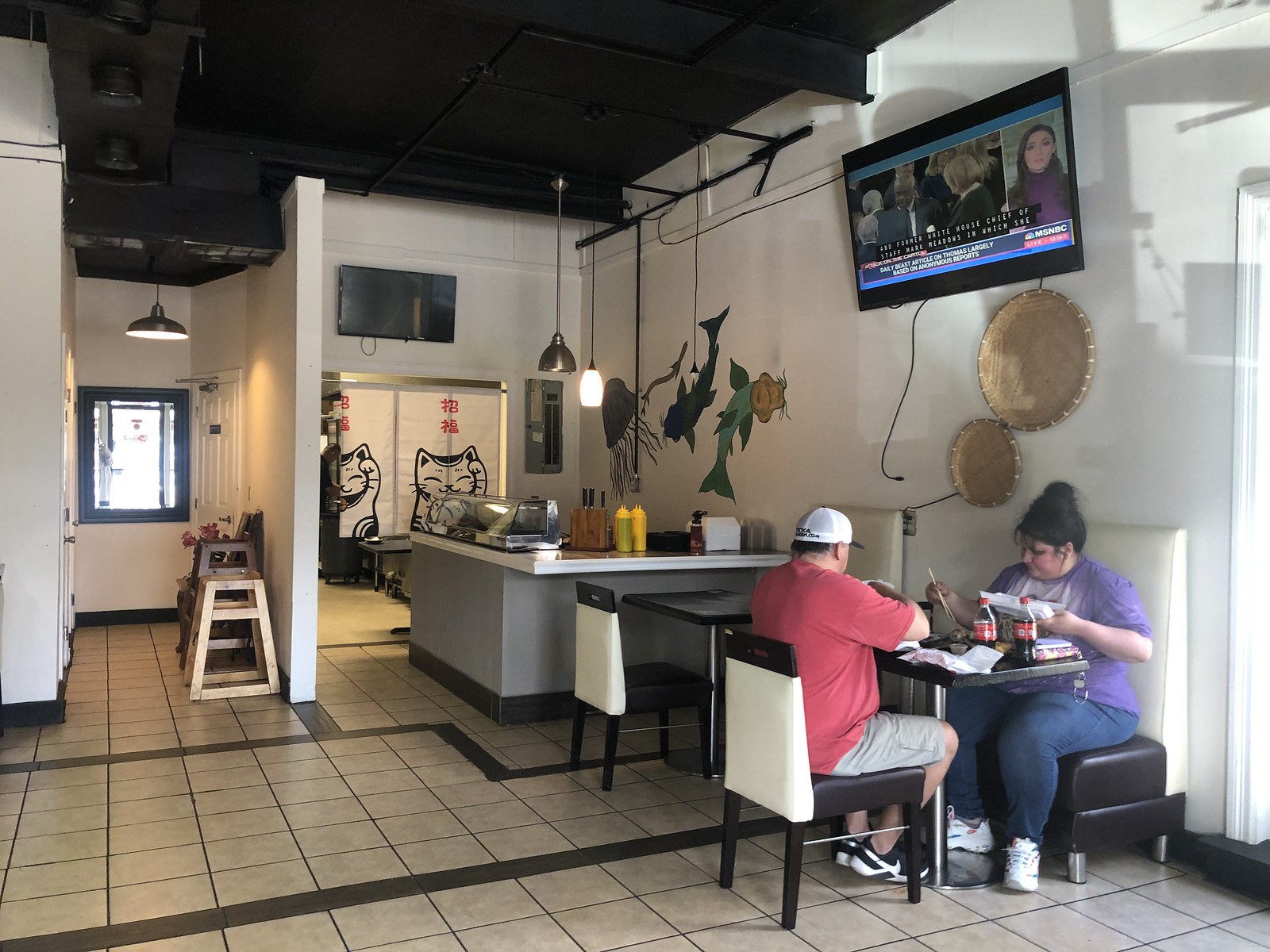
I wasn't in the mood for ramen on this particular day so I went for a few other things. Starting with, of course, crab rangoons. Imitation crab, cream cheese all wrapped up and fried. These are such a guilty pleasure; I will get these everywhere. I did like the shape of these because there's that big pocket of cheese and I can discard the too-crunchy ends.
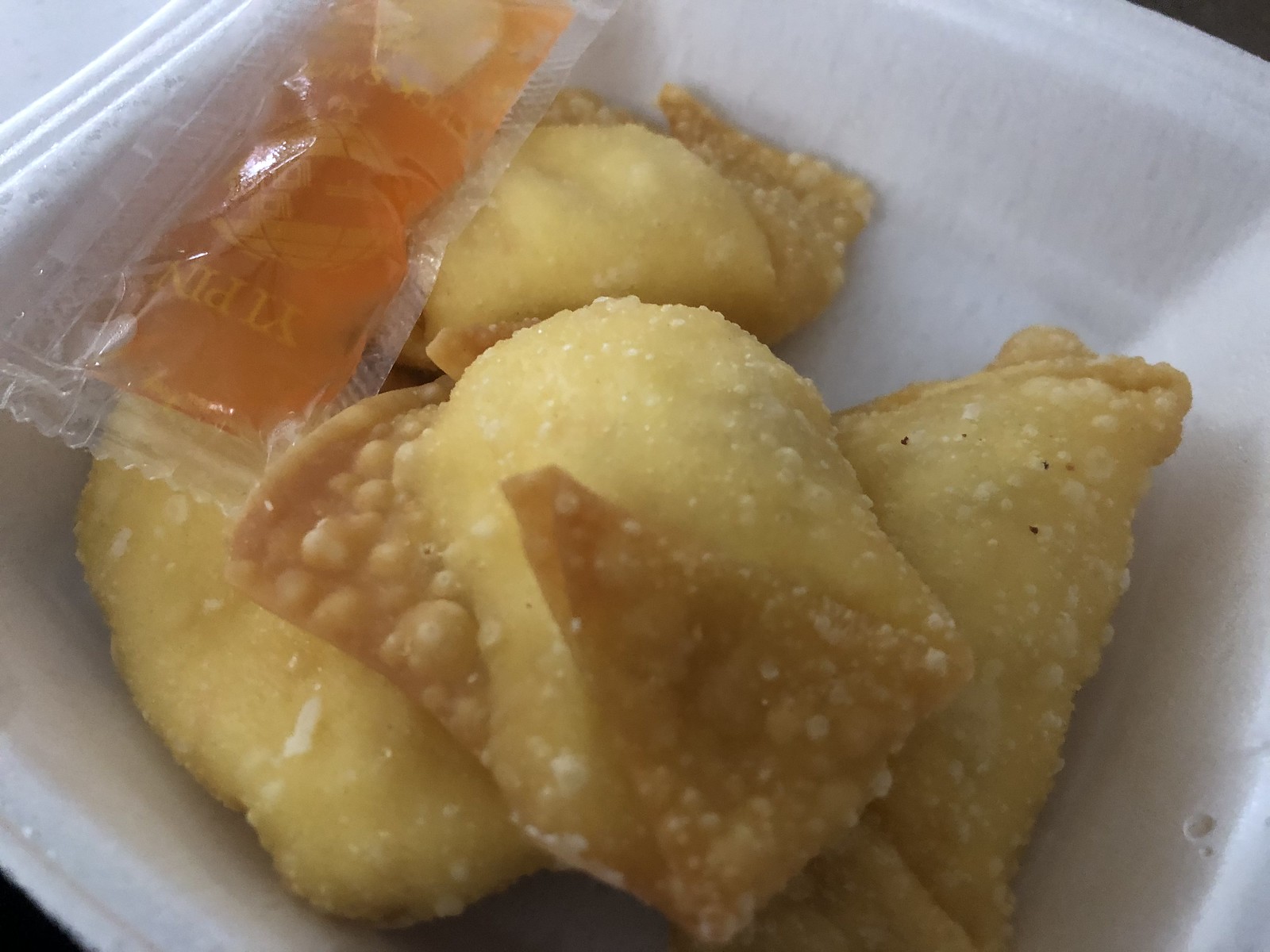
I also ordered two rolls: The West Virginia Roll and a shrimp tempura roll. The former is "Deep fried, crabmeat, avocado, cream cheese, Chef's sauce." This is usually my go-to combo (again, guilty pleasure) but the fried portion has been taking over my palate and the overwhelming flavor is oil.
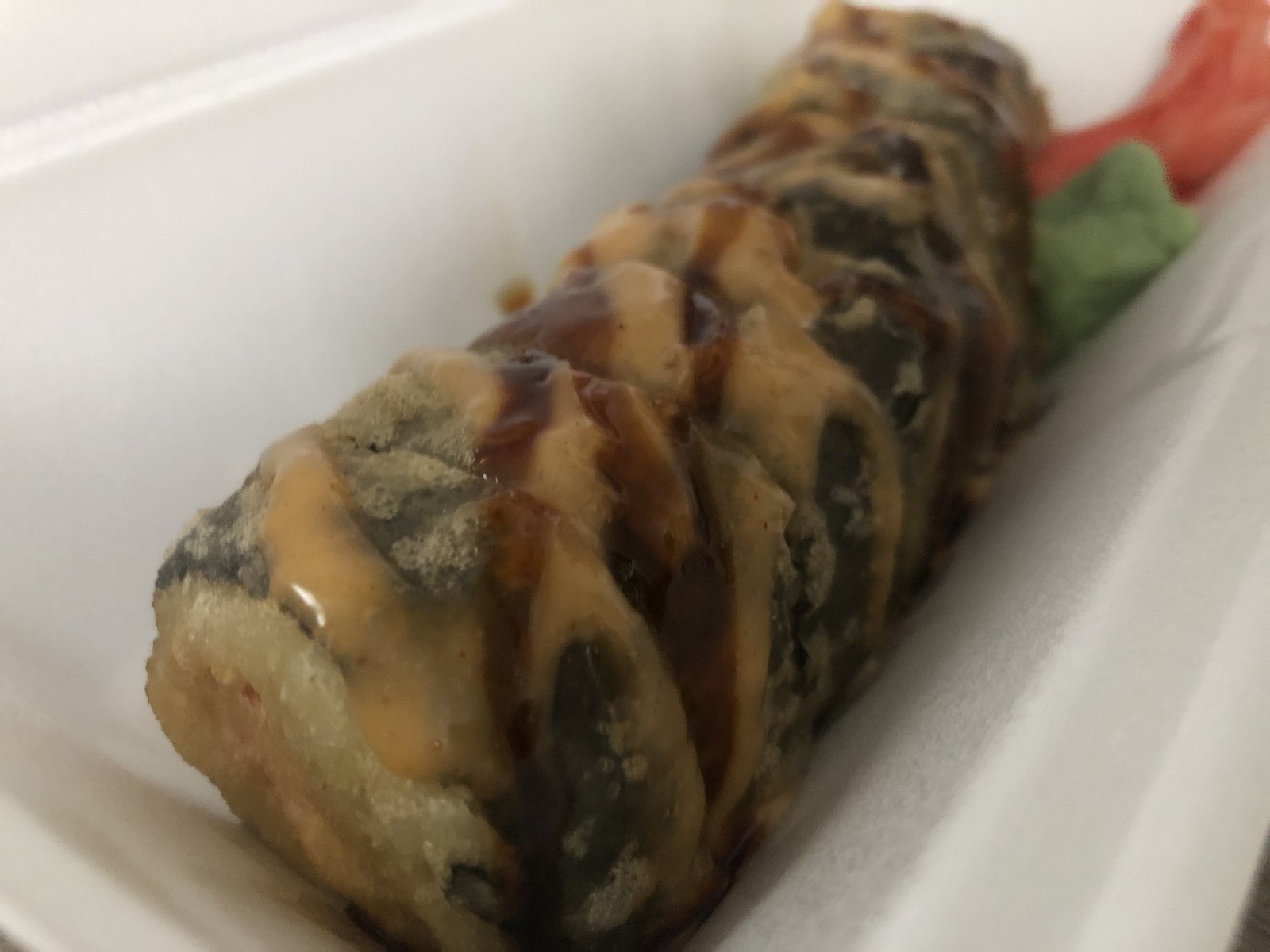
The shrimp tempura roll is a more reliable go-to and doesn't make everything taste oily. A bit crunchy, a bit creamy. That's the balance I enjoy.
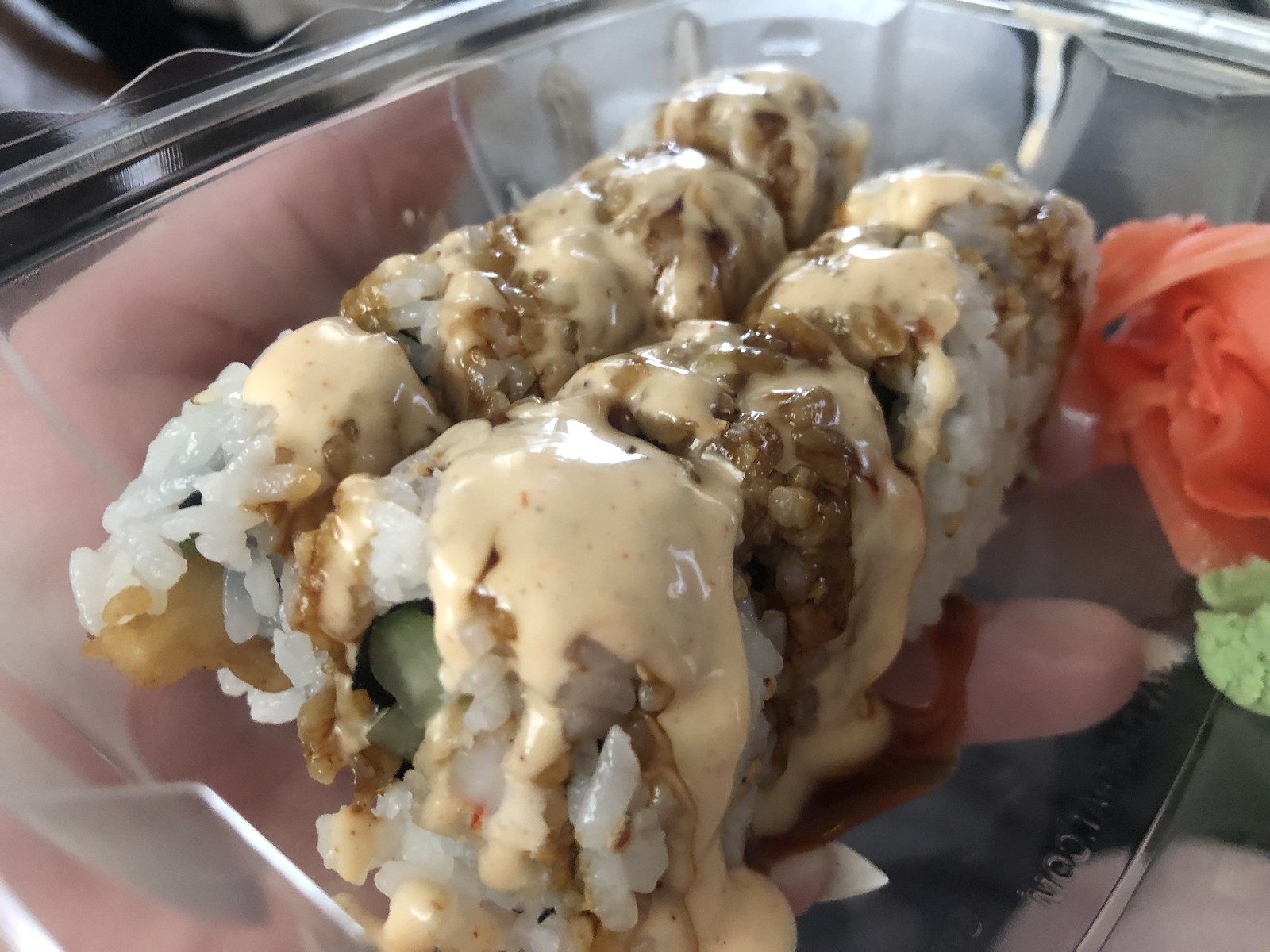
Grade: B

West Virginia is now home to a ramen restaurant - the first of which I'm familiar with.
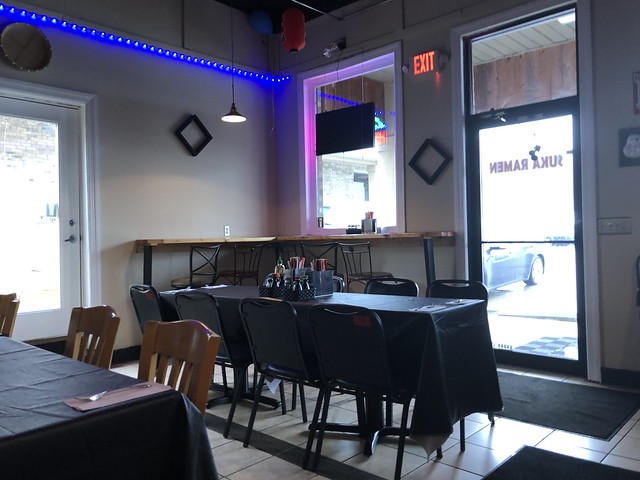 Suka Ramen, located in Hurricane, has more than just ramen on their menu, though. They also have sushi, poke bowls, curry and hibachi.
Suka Ramen, located in Hurricane, has more than just ramen on their menu, though. They also have sushi, poke bowls, curry and hibachi. 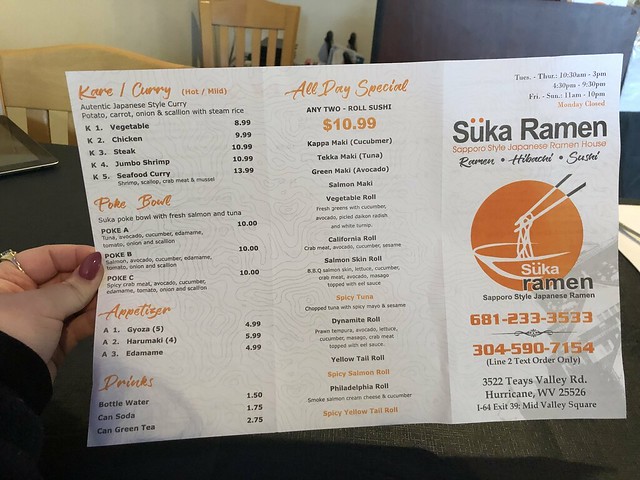 But since ramen is the namesake, I decided to try that out. They have a handful of main kinds: miso ramen, tonshio ramen, shoyu ramen, shio ramen and more.
But since ramen is the namesake, I decided to try that out. They have a handful of main kinds: miso ramen, tonshio ramen, shoyu ramen, shio ramen and more.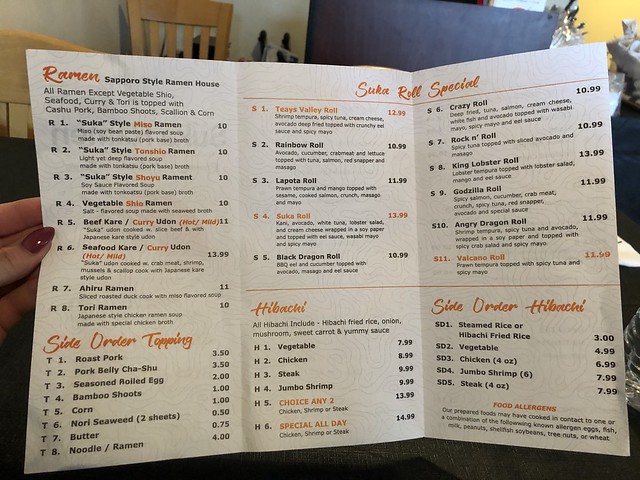 I'm not the best person to describe these different types, but here's a quick explainer:
I'm not the best person to describe these different types, but here's a quick explainer:I ultimately ended on the "miso" ramen because I read that it's a bit sweeter. And more familiar with those of us who have had miso soup at some point. Next time, I want to try the seafood with udon, because I like my noodles a bit thicker and denser. Which is your favorite?

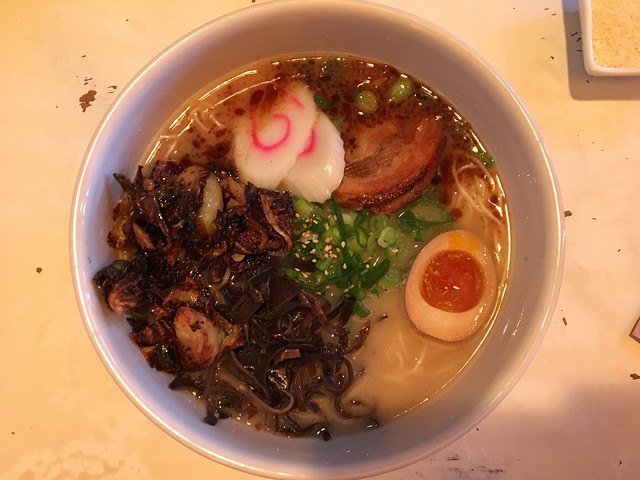 The ramen craze is alive and well in hipster town Austin. And, according to one publication, it is home to the best ramen joint in the country.
The ramen craze is alive and well in hipster town Austin. And, according to one publication, it is home to the best ramen joint in the country. Ramen Tatsu-Ya is "Japanese Soul Food" with OG ramen: pork bone broth, chashu, ajitama, wood ear mushroom and scallions.
Ramen Tatsu-Ya is "Japanese Soul Food" with OG ramen: pork bone broth, chashu, ajitama, wood ear mushroom and scallions.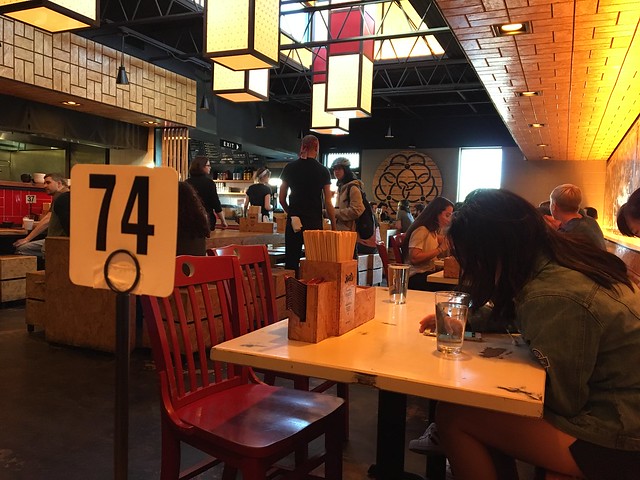
Ramen Tatsu-ya is the long-awaited collaboration between local chefs/DJs, Tatsu Aikawa and Takuya Matsumoto. The two of them first met as they were busy making their marks on the Austin scene as hip-hop DJs. After following an eerily parallel timeline, honing their crafts at notable Austin establishments such as Musashino and Second Bar + Kitchen, Tatsu took a leap and moved to Los Angeles. There, he worked in one of the nation’s most respected Kaiseki/Sushi bars, the two Michelin star restaurant Urasawa.
On his return, he began working with Takuya on birthing Tatsu-ya. “I was craving good ramen after having lived in Japan and LA. I wanted to provide that same quality and authenticity in Austin, the city I call home.” says Tatsu. “We want to educate people on what ramen truly is. It’s the soul food of Japan. The process of broth-making can take an extremely long time in order to draw out the flavors from each ingredient.” A far cry from the 10-cent package ramen most of us know all too well (ABOUT).
A Culinary Equation :: Episode 1 - Ramen from Palate Films on Vimeo.
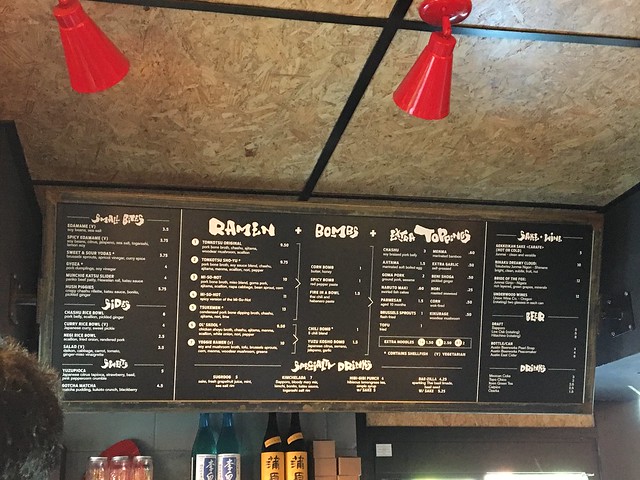 You order at the front of the place, and there was a small line. Pick which ramen you want (I went with the original), add "bombs" if you want, and add any toppings you may like - I added naruto maki, which are those swirled fish cakes and brussels sprouts and some parmesan. Because why not?
You order at the front of the place, and there was a small line. Pick which ramen you want (I went with the original), add "bombs" if you want, and add any toppings you may like - I added naruto maki, which are those swirled fish cakes and brussels sprouts and some parmesan. Because why not?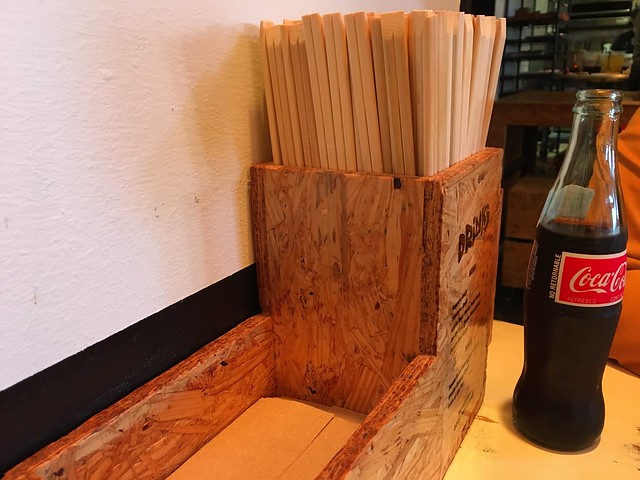
1. Chopsticks only! (Training chopsticks available on request.)
2. Sip the broth first, before digging into your noodles. Allow the steam to waft into your face and savor the smell; feel it run down your spine.
3. Finish all the noodles before they get soggy!
4. Never share your ramen. Never!
5. Slurp! Do it loudly and shamelessly. This aerates the broth and enhances the flavor of the noodles, similar to wine.
6. Add toppings after sampling the original flavors.7. If you’re still hungry after finishing your noodles, but have some broth remaining you can request more by saying “Kaedama please!” (Kae-dama meaning: “Extra noodles!”) (RULES)
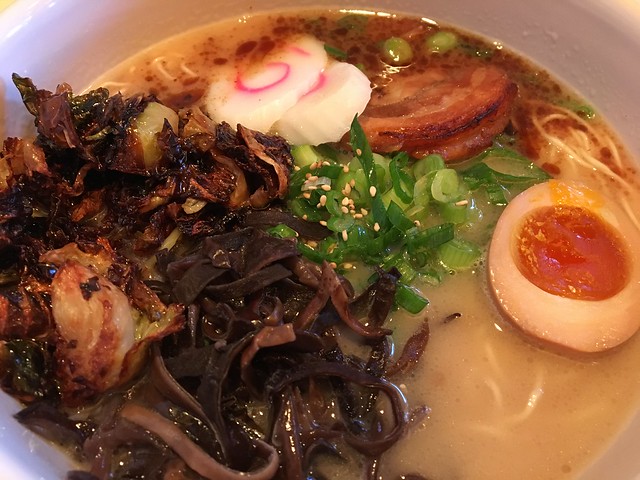 After a little wait, the bowls for me and my friend Julia were brought out. I thought this was absolutely fantastic. The broth has a really deep, rich flavor, and all of those delicious ingredients just pop. Fresh veggies, deliciously cooked pork belly, crispy sprouts. All of it together was just really, really good. Definitely plan to have a full - but happy - belly leaving here.
After a little wait, the bowls for me and my friend Julia were brought out. I thought this was absolutely fantastic. The broth has a really deep, rich flavor, and all of those delicious ingredients just pop. Fresh veggies, deliciously cooked pork belly, crispy sprouts. All of it together was just really, really good. Definitely plan to have a full - but happy - belly leaving here.Grade: A
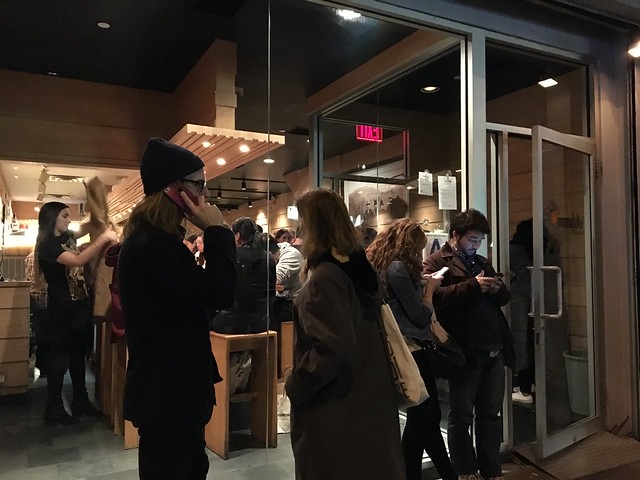 Remember how I said ramen is a thing now? It is. And Momofuku Noodle Bar in New York City is doing it very well.
Remember how I said ramen is a thing now? It is. And Momofuku Noodle Bar in New York City is doing it very well. Like literally every other thing in this city, we waited a very long time for our table. Finally, we were seated along the long table with strangers on either side of us and looked over the menu.
Like literally every other thing in this city, we waited a very long time for our table. Finally, we were seated along the long table with strangers on either side of us and looked over the menu.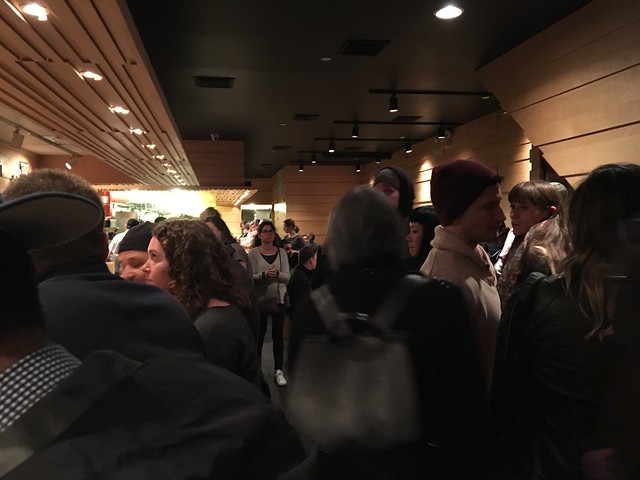
 We put in an order of the pork buns (not on the menu but clearly ordered often). This was a very good decision.
We put in an order of the pork buns (not on the menu but clearly ordered often). This was a very good decision.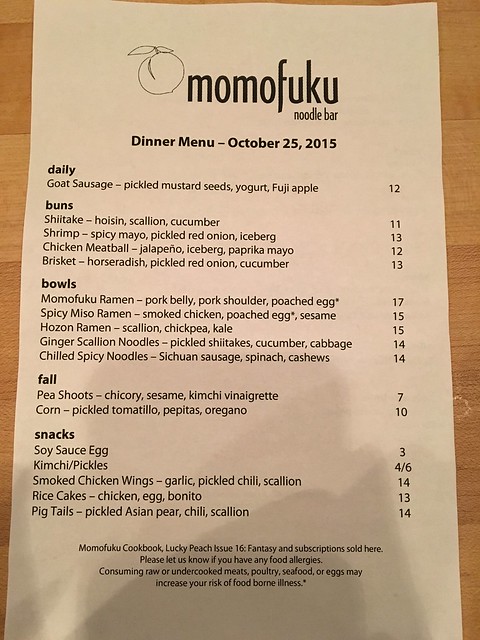 The pork buns were just two bites or so each, but talk about some flavor! I love the texture of that chewy bun, plus super tender pork and a nice tangy sweet sauce. Just divine.
The pork buns were just two bites or so each, but talk about some flavor! I love the texture of that chewy bun, plus super tender pork and a nice tangy sweet sauce. Just divine.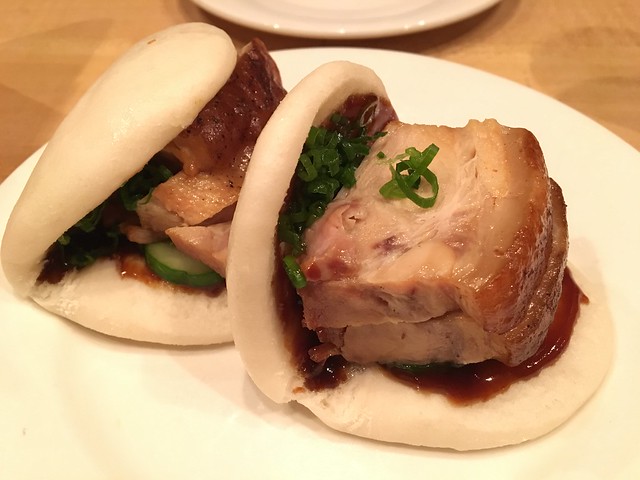 My main entree was the Momofuku Ramen - with pork belly, pork shoulder and a poached egg. This ramen was a good bit different from the other I had back in Boston. It was clearly a prettier presentation. And, there were more extraneous ingredients beyond noodles and broth. Plus I loved the little fish cake on the side!
My main entree was the Momofuku Ramen - with pork belly, pork shoulder and a poached egg. This ramen was a good bit different from the other I had back in Boston. It was clearly a prettier presentation. And, there were more extraneous ingredients beyond noodles and broth. Plus I loved the little fish cake on the side!  My verdict: I love the broth. This broth is so delicious. It's salty - but not overly salty - and hot and soothing. I liked the larger, chewier noodles better than these ones. THOUGH, these are much easier to eat. The pork is delicious, and I love the fish cake. A good bit of other ingredients helped break up texture so it's not just a big bowl of soup.
My verdict: I love the broth. This broth is so delicious. It's salty - but not overly salty - and hot and soothing. I liked the larger, chewier noodles better than these ones. THOUGH, these are much easier to eat. The pork is delicious, and I love the fish cake. A good bit of other ingredients helped break up texture so it's not just a big bowl of soup. Grade: A
Grade: A In the past few years, "ramen" has become increasingly mainstream. It's no longer just a utilitarian Japanese noodle soup dish. It has formed into this trendy dish popping up all over Western cities.
In the past few years, "ramen" has become increasingly mainstream. It's no longer just a utilitarian Japanese noodle soup dish. It has formed into this trendy dish popping up all over Western cities.And, no, I'm not talking about the instant ramen mass-produced as a block of dried noodles with an accompanying spice packet that sells for about 20 centers per package. Ramen is the Chinese-style wheat noodles served in a meat-based broth with soy, miso, slices of pork, nori, fish cake and green onions.
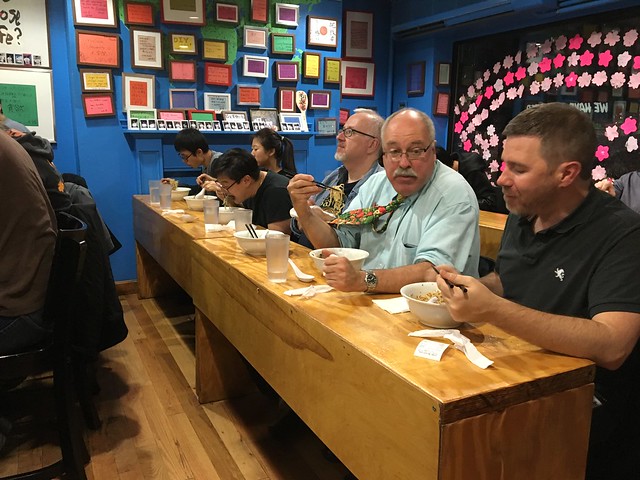 In Boston, Yume Wo Katare is known to have some of the best ramen around. As it should because it literally only serves on item: the pork ramen. You can add extra meat. Yume Wo Katare is also cash only, has a long line no matter what time of day and has just three rows of bench seating, where you face the chef and are ultimately judged on how much you are able to eat. It's certainly an experience.
In Boston, Yume Wo Katare is known to have some of the best ramen around. As it should because it literally only serves on item: the pork ramen. You can add extra meat. Yume Wo Katare is also cash only, has a long line no matter what time of day and has just three rows of bench seating, where you face the chef and are ultimately judged on how much you are able to eat. It's certainly an experience.After waiting for a long time outside, it was finally our turn to pass through the door. Except, they split our party up into two and two (instead of four) so that it would be more simple to seat us. There are only 18 seats here afterall. We placed our order at the cash register, paid, grabbed our cup and pour a glass of water before shimmying into our place on the bench. Soon after, the other half of our party was seated in the row in front of us. We sit quietly and patiently as some of the people finish up their meals. One of the Yume Wo Katare chefs announces every so often "We gotta Perfect!!" or "It's a Next Time!" dependent upon how much of the ramen was finished.
Soon, as the chefs begin to prepare our meals, we were asked if we wanted garlic or not. The answer to that question is always yes. And before long, there is this massive, overwhelming piping hot bowl of ramen.
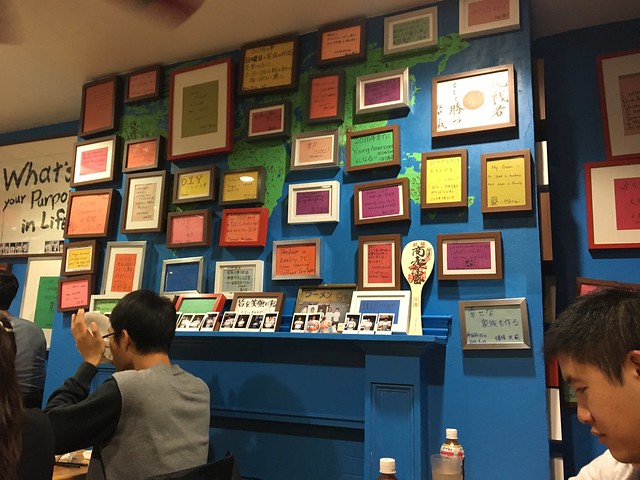 There are a few general types of ramen: shio (pale, clear, yellow, salty broth made with chicken, vegetables fish and seaweed), tonkotsu (a cloudy white broth used by boiling pork bones, fat over high heat for many hours), shoyu (clear brown broth, made with soy sauce so it's tangy, salty and and savory) and miso (contains miso, so it's tangy and slightly sweet).
There are a few general types of ramen: shio (pale, clear, yellow, salty broth made with chicken, vegetables fish and seaweed), tonkotsu (a cloudy white broth used by boiling pork bones, fat over high heat for many hours), shoyu (clear brown broth, made with soy sauce so it's tangy, salty and and savory) and miso (contains miso, so it's tangy and slightly sweet).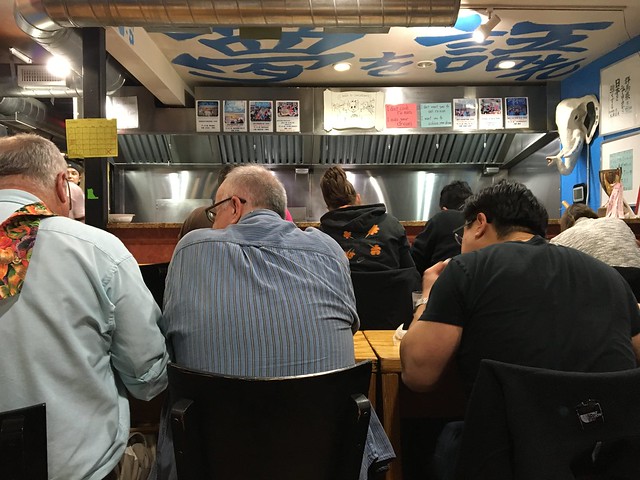 Yume Wo Katare serves jiro ramen, which is a tonkotsu broth with shoyu added. The noodles are very thick and chewy. This giant bowl has a heaping ton of thick noodles in a fatty broth with a few tender pieces of pork belly, mixed in with bean sprouts, bok choy and lots of minced garlic.
Yume Wo Katare serves jiro ramen, which is a tonkotsu broth with shoyu added. The noodles are very thick and chewy. This giant bowl has a heaping ton of thick noodles in a fatty broth with a few tender pieces of pork belly, mixed in with bean sprouts, bok choy and lots of minced garlic.I love the thick, chewy noodles, and the broth, while salty, was very good. I slurped up my soup, alternating between my chopsticks and spoon. It is a method that takes some practice, but I entered into a rhythm. But after I finished all my noodles, it felt like there was a rock in my belly. I looked down to see a full bowl of broth and some pork left. I took a few spoonfuls of just the broth - but there's no way I could hold all that in. It's so rich and fatty and greasy - and without the noodle to cut through it, it just wasn't going to happen. I took a break, hoping to make room in my belly - regretting everything I ate earlier in the day. There was so much pressure! They announce to everyone how you did! I wanted to do well! Unfortunately, when it was my turn to be judged, I received an "Almost!" That's better than a "Next Time!" so I was actually proud of myself. Even though the other three members of my group all got "Perfect!"
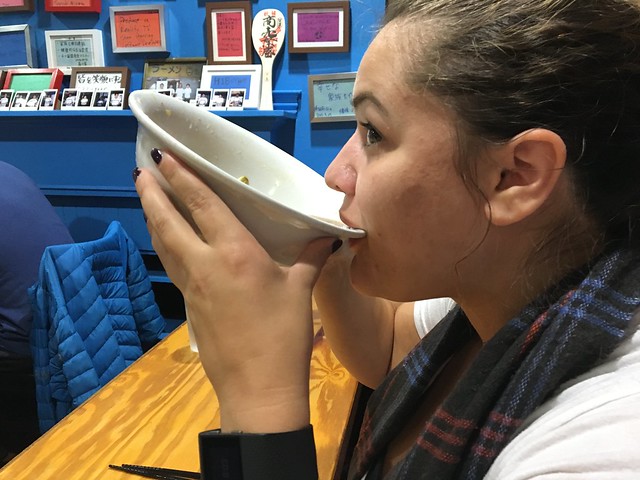 At the end of the meal, you're allegedly encouraged to "share your dream," and there are signs hanging up of previous patrons' dreams. This didn't happen while I was there, but it is apparently a big part of the experience. You're encouraged to be quiet and focus on your ramen - apparently as a symbol of what you can accomplish - and if you finish your ramen, you can accomplish your dream.
At the end of the meal, you're allegedly encouraged to "share your dream," and there are signs hanging up of previous patrons' dreams. This didn't happen while I was there, but it is apparently a big part of the experience. You're encouraged to be quiet and focus on your ramen - apparently as a symbol of what you can accomplish - and if you finish your ramen, you can accomplish your dream.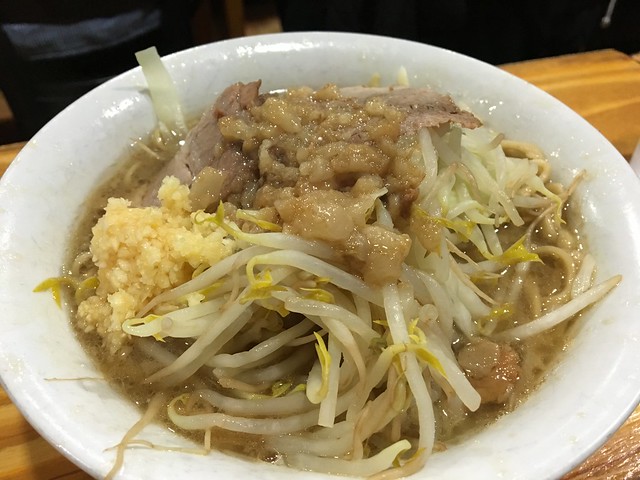 My only dream at that moment was to keep everything I just ingested inside of me. This was the first time I ever ate so much, I was genuinely concerned I might throw up. We thankfully had about maybe a half mile or so walk back to the apartment so I could try to get some of that to settle.
My only dream at that moment was to keep everything I just ingested inside of me. This was the first time I ever ate so much, I was genuinely concerned I might throw up. We thankfully had about maybe a half mile or so walk back to the apartment so I could try to get some of that to settle.This isn't a casual, carefree light dinner. It's a TON of food, it's almost served militant style, and there's pressure to perform. That said, it's also fun. Just be sure to get mentally prepared first.
Grade: A
All work property of Candace Nelson. Powered by Blogger.





